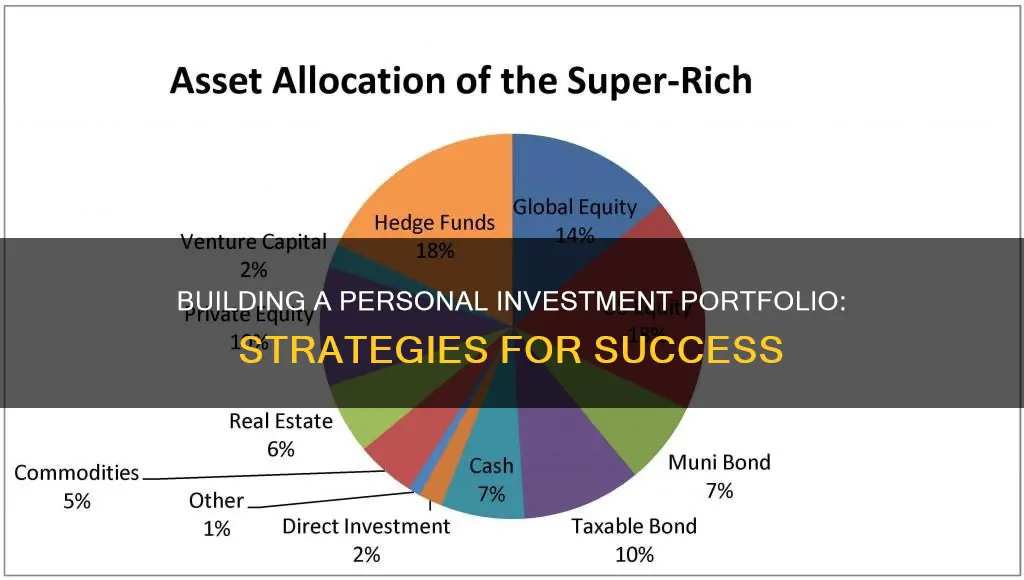
Building an investment portfolio is a thoughtful, holistic endeavour that requires weighing up a variety of factors, from your life circumstances to your risk tolerance and age. The process doesn't have to be complicated, but it's important to understand the basics. An investment portfolio is a collection of assets that you buy or deposit money into to generate income or capital appreciation. These assets can include stocks, bonds, mutual funds, exchange-traded funds (ETFs), real estate, and even cryptocurrencies.
The first step in building an investment portfolio is to define your financial goals and risk tolerance. Are you saving for retirement, a down payment on a house, or your child's college fund? How much of an unrealized loss are you willing to endure? Knowing your risk tolerance will help you determine the types of investments to include in your portfolio.
Once you've set your goals and understood your risk tolerance, you can start choosing your investments. Diversification is key to managing risk, so consider including a mix of asset types such as equities (stocks and funds), fixed-income investments (bonds), and cash or cash equivalents. You can also diversify across different tax-exposure strategies by contributing to both tax-advantaged retirement accounts and taxable brokerage accounts.
Finally, remember to regularly monitor and rebalance your portfolio to ensure it remains aligned with your goals. Building an investment portfolio takes time and careful consideration, but by following these steps, you'll be well on your way to creating a strong investment strategy.
| Characteristics | Values |
|---|---|
| Investment goals | Retirement, down payment on a home, child's college fund |
| Time horizon | Short-term, medium-term, long-term |
| Risk tolerance | Aggressive, moderate, conservative |
| Investment accounts | Tax-advantaged accounts (IRAs, 401(k)s), taxable online brokerage accounts, deposit accounts (CDs, money market accounts, high-yield savings accounts) |
| Investments | Stocks, bonds, mutual funds, exchange-traded funds (ETFs), real estate, cryptocurrencies, hedge funds, commodities |
| Asset allocation | Stocks (large-cap, mid-cap, small-cap, domestic, foreign), bonds (short-term, long-term, government debt, corporate debt), cash and cash alternatives |
| Diversification | Achieved through mutual funds and ETFs |
| Rebalancing | Monitor and adjust portfolio regularly, sell overweighted securities and buy underweighted securities |
What You'll Learn

Understanding your risk tolerance
Your risk tolerance is also tied to how comfortable you are with seeing your investments fluctuate in value. If you are investing for the long term, a drop in the value of your portfolio during a stock market crash might not concern you. However, if the idea of seeing your portfolio value fall by, say, 20% fills you with dread, you will want to adopt a more conservative strategy.
Your risk tolerance will determine your asset allocation, or the types of investments you select and in what proportions. Stocks, for example, tend to produce the highest returns but can be volatile over the short term. Bonds, on the other hand, have lower long-term returns but are less risky than stocks. Combining these asset classes in varying proportions can create a range of risk-return profiles to suit different investors.
It's worth noting that your risk tolerance can change over time. For instance, a young person who doesn't depend on their investments for income can afford to take greater risks. However, as they get older and closer to retirement, they may want to focus on protecting their assets. Therefore, it's important to periodically reassess your risk tolerance and make adjustments to your portfolio as necessary.
Savings-Investment Identity: Understanding the Logical Balance
You may want to see also

Choosing an account that works for your goals
Choosing an account that works towards your goals is a crucial step in building an investment portfolio. There are several types of investment accounts, each serving different purposes. Here are some factors to consider when selecting an account that aligns with your objectives:
- Investment Goals: Firstly, identify your investment goals. Are you investing for retirement, saving for a down payment on a house, or funding your child's education? Different accounts offer distinct advantages for various financial objectives. For instance, IRAs are intended for retirement savings and offer tax benefits, whereas regular taxable brokerage accounts are suitable for non-retirement goals.
- Time Horizon: Consider your time horizon, or how long you plan to invest before needing the money. This factor influences your investment strategy and the types of accounts you choose. For example, if you're saving for retirement, you might opt for accounts with long-term investment horizons, such as retirement plans or pension funds.
- Risk Tolerance: Assess your risk tolerance, which refers to your ability to withstand potential losses in your investments. If you have a high-risk tolerance, you may be comfortable with more aggressive investment strategies. On the other hand, if you have a low-risk tolerance, you might prefer more conservative options. Your risk tolerance will guide the types of accounts and investment vehicles you select.
- Tax Implications: Evaluate the tax implications of different investment accounts. Some accounts, like traditional IRAs or 401(k)s, offer tax advantages by allowing you to contribute pre-tax dollars and defer taxation until withdrawal. In contrast, Roth IRAs or Roth 401(k)s are funded with after-tax dollars, enabling tax-free withdrawals in retirement. Diversifying your tax exposure across different types of accounts can be a smart strategy.
- Account Features and Restrictions: Different investment accounts come with varying features and restrictions. For instance, retirement accounts like 401(k)s or IRAs may have contribution limits and early withdrawal penalties. Brokerage accounts, on the other hand, often provide more flexibility in accessing your funds but may not offer the same tax benefits. Understand the specifics of each account type to make an informed decision.
- Account Management: Decide if you want a hands-on or hands-off approach to managing your investments. If you prefer a more passive approach, consider using a robo-advisor or hiring a financial advisor who can manage your portfolio on your behalf. Alternatively, you can choose to actively manage your investments yourself, which requires more time and expertise.
Remember, there is no one-size-fits-all approach to choosing an investment account. Carefully consider your goals, time horizon, risk tolerance, and tax situation to make an informed decision that aligns with your unique circumstances.
Creating a Diversified Investment Portfolio: Strategies for Success
You may want to see also

Selecting investments based on your risk tolerance
- Understand Your Risk Tolerance: Risk tolerance refers to how much loss you are willing to accept in the short term to achieve your investment goals. It is influenced by your time horizon, or how long you plan to hold your investments before needing the money. If you have a long-term goal, such as retirement, you can generally afford to take on more risk. On the other hand, short-term goals usually require a more conservative approach to avoid significant losses.
- Assess Your Personality and Comfort Level: Consider your personality traits and how you handle market volatility. If the idea of short-term losses keeps you up at night, aggressive investments with high-return potential may not be the best fit for you. It's important to strike a balance between risk and comfort to ensure you can stick with your investment strategy.
- Match Risk with Investment Choices: Different investments carry varying levels of risk. Stocks, for instance, typically offer higher returns but come with greater volatility. In contrast, bonds are considered less risky and provide more stable returns. Your risk tolerance will guide you in deciding how much of your portfolio to allocate to stocks, bonds, or other investment options.
- Diversify Your Portfolio: Diversification is a key strategy to manage risk. By spreading your investments across various asset classes, sectors, and companies, you reduce the impact of any single investment on your portfolio's performance. This can be achieved through mutual funds or exchange-traded funds (ETFs) that provide exposure to a diverse range of securities.
- Consider Your Age and Life Stage: Your age and life circumstances play a significant role in determining your risk tolerance. A young professional just starting their career can afford to take on more risk, as they have a longer time horizon and fewer financial commitments. On the other hand, someone closer to retirement age may opt for a more conservative portfolio to protect their assets.
- Monitor and Adjust: Remember that your risk tolerance may change over time as your financial situation, goals, and life circumstances evolve. Periodically review and rebalance your portfolio to ensure it aligns with your current risk tolerance and investment objectives.
The Cycle of Savings, Borrowing, and Investing: Understanding the Trio
You may want to see also

Determining the best asset allocation for you
- Investment goals: Start by defining your investment objectives. Are you investing for retirement, a down payment on a home, or a child's education? Each goal will have a different time horizon and risk profile.
- Risk tolerance: How much risk you are comfortable with will depend on your personality and financial situation. Younger investors with a longer time horizon can generally tolerate more risk, while those closer to retirement may prefer a more conservative approach to preserve their capital.
- Time horizon: Consider how long you plan to invest for. Short-term goals are typically within a year, medium-term goals take one to five years, and long-term goals are over five years. Your time horizon will influence the types of investments you choose.
- Diversification: Diversifying your portfolio across different asset classes, such as stocks, bonds, mutual funds, and exchange-traded funds (ETFs), can help manage risk and smooth out returns. Diversification can be achieved through mutual funds or ETFs, which offer exposure to a wide range of securities.
- Tax efficiency: Tax implications should also be considered when determining asset allocation. For example, holding dividend-paying stocks in a taxable account can take advantage of lower taxes on qualified dividends.
- Risk/return trade-off: Remember that higher potential returns come with greater risk. While you don't want to eliminate risk entirely, optimising it for your situation is key. Younger investors can typically take on more risk, while those nearing retirement may want to focus on protecting their assets.
- Model portfolios: Looking at model portfolios can give you an idea of how aggressive, moderate, and conservative portfolios are constructed. However, remember that a model portfolio may not be the right fit for your specific circumstances.
Once you've determined your asset allocation, you can start selecting the individual investments that align with your goals and risk tolerance. It's important to regularly monitor and rebalance your portfolio to ensure it stays aligned with your investment strategy.
Betterment: Savings or Investment?
You may want to see also

Rebalancing your portfolio as needed
Once you have established an investment portfolio, it is important to monitor and adjust it regularly. For example, you might check in on your portfolio twice a year to ensure your asset allocation is still aligned with your goals. You may also need to rebalance your holdings if the market has been volatile.
Some advisors recommend rebalancing at set intervals, such as every six or 12 months, or when the allocation of one of your asset classes (such as stocks) shifts by more than a predetermined percentage, such as 5%. For example, if you had an investment portfolio with 60% stocks and it increased to 65%, you may want to sell some of your stocks or invest in other asset classes until your stock allocation is back at 60%.
You may also need to adjust your investment strategy as your life changes. Getting married or divorced, becoming a parent, receiving an inheritance or nearing retirement are all life events that could necessitate rethinking your current investment strategy.
When rebalancing and readjusting your portfolio, take a moment to consider the tax implications of selling assets at a particular time. For example, if you were to sell all of your equity positions to rebalance your portfolio, you may incur significant capital gains taxes. In this case, it might be more beneficial to simply not contribute any new funds to that asset class in the future while continuing to contribute to other asset classes.
Finally, remember to maintain your diversification. It is not enough to simply have a range of asset classes; you must also diversify within each class. Ensure that your holdings within a given asset class are spread across an array of subclasses and industry sectors.
Investing vs. Saving: Which is Riskier?
You may want to see also
Frequently asked questions
An investment portfolio is a collection of assets that you buy or deposit money into to generate income or capital appreciation. It can include stocks, bonds, mutual funds, exchange-traded funds (ETFs), real estate, cash and cash alternatives, and more.
The first step is to set clear financial goals and understand your risk tolerance and time horizon. Your risk tolerance is how much of an unrealized loss you're willing to accept, and the time horizon is how long you have until you start making withdrawals.
Next, you need to decide on your asset allocation, which is the proportion of each type of asset in your portfolio. This will depend on your goals, risk tolerance, and time horizon.
Finally, you can choose specific investments that fit your asset allocation and risk profile.
You can choose to invest in individual stocks, bonds, mutual funds, or ETFs. When choosing individual stocks, consider investing in companies that you are familiar with and whose products or services you use. You can also look at financial statements to evaluate their sales growth, profitability, and cash on hand. Diversification is key, so it's important to choose a variety of investments across different sectors and industries.







